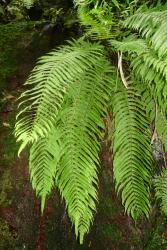Terrestrial ferns. Rhizomes usually erect or suberect (NZ), rarely long-creeping (not NZ), scaly. Rhizome scales ovate, thin, appressed, often with marginal hairs (not NZ) or entire (NZ). Fronds monomorphic. Stipes scaly, sometimes spiny (not NZ). Laminae 1-pinnate to 2-pinnate-pinnatifid, herbaceous, several pairs of lower pinnae gradually or abruptly reduced in size; basal pinnae auricled acroscopically; aerophores at base of pinnae white and swollen in young living fronds; abaxial surface of laminae bearing a few ovate scales (NZ) or lacking scales (not NZ); abaxial surface bearing short acicular hairs, and sometimes a few capitate or glandular hairs, or glabrous; sessile spherical glands absent. One or more basal veins from adjacent pinna lobes uniting below the sinus (NZ) or rarely veins free (not NZ). Sori round, indusiate (not NZ) or exindusiate (NZ); paraphyses absent. Indusia (when present) reniform, glabrous or bearing acicular hairs. Sporangia usually bearing short capitate hairs near the annulus, and a multicellular hair with a swollen apical cell on the stalk (not NZ) or both such hairs absent (NZ). Spores monolete, with many wings.
Allan (1961) included all New Zealand species of Thelypteridaceae within a broadly construed Thelypteris. Holttum (1971,1973) recognised Pneumatopteris as a genus characterised by a usually erect rhizome, stipes bearing broad scales often with hairs on the margins, at least one pair of greatly reduced basal pinnae, aerophores white and more or less swollen in fresh material, basal veins on adjacent pinnules usually anastomosing, lower lamina surface usually pustular when dry, lacking glands and never densely hairy, sori usually indusiate, sporangia usually bearing short capitate hairs near the annulus and multi-cellular hairs with swollen apical cells on the sporangial stalks. Smith et al. (2006) included Pneumatopteris within a broadly circumscribed Cyclosorus. Holttum’s classification is followed here (see Taxonomy under Thelypteridaceae), although the sole New Zealand representative of Pneumatopteris is an atypical member of the genus as construed by him (see Notes under P. pennigera).
A genus of c. 80 species distributed from tropical Africa, Asia, Malesia, Australia and the Pacific islands to Hawai‘i in the north and New Zealand in the south (Smith 1990); three species in Australia (Bostock 1998) and 17 in the Pacific (Holttum 1977). One species in New Zealand; none endemic.
| Category | Number |
|---|---|
| Indigenous (Non-endemic) | 1 |
| Total | 1 |
The base chromosome number in Pneumatopteris is x = 36 (Holttum 1971; Smith 1990).




